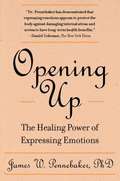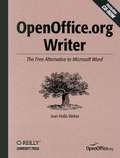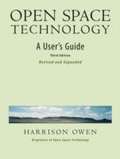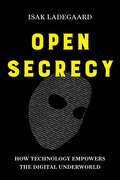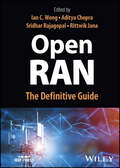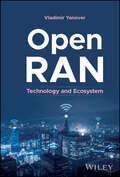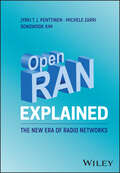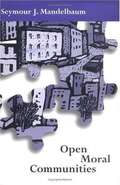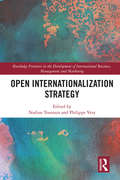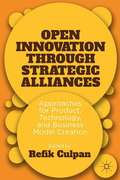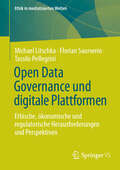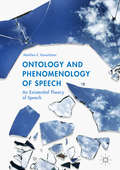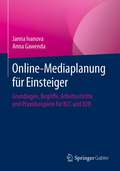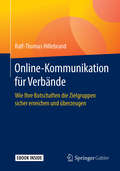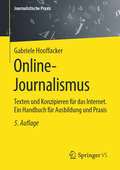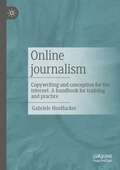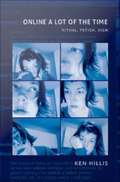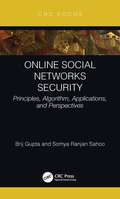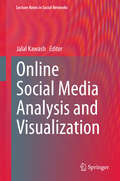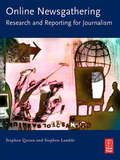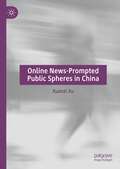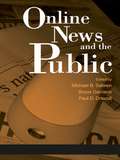- Table View
- List View
Opening Up: The Healing Power of Expressing Emotions
by James W. PennebakerUsing original research, Dr. James Pennebaker presents astounding evidence for the health benefits of personal self-disclosure, offering sound advice on how each of us can confront and conquer buried turmoil and get on the road to good health.
OpenOffice.org Writer
by Jean Hollis WeberThanks to OpenOffice.org, there is an alternative to Microsoft Word. If you've ever been frustrated by Word's quirks and limitations--including its price tag--and longed for a practical alternative, then it's time to break free. OpenOffice.org is the free, open source office suite and its word processor, Writer, has proven extremely popular with both Windows and Linux users. How good can it be if it's free? you might ask. And how much trouble will it be to install and learn? A quick tour of the program will show you: the features you use regularly--from formatting and spell check to using templates and creating indexes --are all there. And Writer's intuitive, surprisingly familiar interface lets you navigate with ease. To quickly master the ins and outs of Writer, you'll want a copy of OpenOffice.org Writer: The Free Alternative to Microsoft Word . This handy reference is packed with essential information to help you learn the basics of Writer and become adept with its advanced features. Written for intermediate and advanced users of word processing programs, OpenOffice.org Writer: The Free Alternative to Microsoft Word provides guidance for common and advanced word processing tasks. With this book, you'll learn how to: Set up OOoWriter to work your way Write, edit, and review documents Control page layout Use templates and styles effectively Get the most from using fields Work with Tables of contents, indexes, bibliographies Manage large or complex documents Insert, edit and create graphics Make a smooth transition from Microsoft Word OpenOffice.org Writer: The Free Alternative to Microsoft Word provides guidance for anyone who wants to break out of the Word rut. Its detailed Table of Contents make it a handy reference for even the most experienced word processing users who want to get up to speed quickly with this program, or make sure they're taking full advantage of OOo Writer's features. With the complete office suite included on a CD (which you can install on as many machines as you like), this book makes using Writer an easy decision. OpenOffice.org Writer: The Free Alternative to Microsoft Word is part of the O'Reilly Community Press Series. Unlike classic O'Reilly animal books, O'Reilly's role in the series is limited to providing manufacturing and distribution services rather than editorial development, so that each Community Press title reflects the editorial voice and organization of the community that has created it.
Open to Outcome: A Practical Guide for Facilitating & Teaching Experiential Reflection (2nd Edition)
by Micah Jacobson Mari RuddyWith the first edition of Open to Outcome, tens of thousands of educators and learners experienced and benefited from The 5 Questions model for facilitating reflective discussions. This second edition builds on the solid foundation of the first, offering ingeniously simple changes to the 4th and 5th questions, the addition of a new chapter on specific outcomes, and other updates to make this proven processing method even more powerful and effective.
Open Standards and the Digital Age
by Andrew L. RussellHow did openness become a foundational value for the networks of the twenty-first century? Open Standards and the Digital Age answers this question through an interdisciplinary history of information networks that pays close attention to the politics of standardization. For much of the twentieth century, information networks such as the monopoly Bell System and the American military's Arpanet were closed systems subject to centralized control. In the 1970s and 1980s, however, engineers in the United States and Europe experimented with design strategies to create new digital networks. In the process, they embraced discourses of "openness" to describe their ideological commitments to entrepreneurship, technological innovation, and participatory democracy. The rhetoric of openness has flourished - for example, in movements for open government, open source software, and open access publishing - but such rhetoric also obscures the ways the Internet and other "open" systems still depend heavily on hierarchical forms of control.
Open Space Technology: A User's Guide (3rd edition)
by Harrison OwenWhat if you could identify a mission-critical issue for your organization, bring together the people with something to contribute and something at stake, focus on that issue and take decisive action all in the same meeting? A fantasy? Not with the application of Open Space Technology. Open Space Technology is a methodological tool that enables self-organizing groups of all sizes to deal with hugely complex issues in a very short period of time. Authored by the originator of Open Space Technology, Open Space Technology: A User's Guide details what needs to be done before, during, and after an Open Space event. It is the most authoritative book available on how to plan and run a successful Open Space event. This 3rd edition adds a survey of the current status of Open Space Technology around the world, an updated section on the latest available technology for report writing (a key aspect of the Open Space process), and an updated list of resources.
Open Secrecy: How Technology Empowers the Digital Underworld
by Isak LadegaardExamines how the global digital underground is liberated by "open secrecy"—a novel and ominous mix of tools for mass communication and anonymity Shadowy groups are increasingly capable of collective action. Using military-grade encryption, rerouting software, and cryptocurrencies, anonymous and pseudonymous actors can now communicate, solve problems, recruit members, and manage resources across multiple public and semipublic spaces. This swirling mix of secrecy and openness enables people to move through cyberspace like nomads with verifiable personas, which makes them impossible to stop. Isak Ladegaard takes readers inside a dark, digital economy for banned drugs that has survived numerous police crackdowns, examines how activist software developers in China and other countries have maintained paths to the open internet, and documents how the American far right uses the same tools to sustain antisocial movements based on paranoia and hate. Timely and perceptive, Open Secrecy argues that although information technology enables mass surveillance, it also undermines state power by boosting groups that evade its rule. These dual forces of control and liberation are propelling us forward, with no one at the wheel.
Open RAN: The Definitive Guide
by Ian C. Wong Aditya Chopra Sridhar Rajagopal Rittwik JanaOpen RAN A comprehensive survey of Open RAN technology and its ecosystem In Open RAN: The Definitive Guide, a team of distinguished industry leaders deliver an authoritative guide to all four principles of the Open RAN vision: openness, virtualization, intelligence, and interoperability. Written by the industry experts currently defining the specifications, building the systems, and testing and deploying the networks, the book covers O-RAN architecture, the fronthaul interface, security, cloudification, virtualization, intelligence, certification, badging, and standardization. This critical reference on Open RAN explains how and why an open and disaggregated, intelligent, and fully virtualized network is the way networks should be designed and deployed moving forward. Readers will also find: A thorough introduction from key industry players, including AT&T, Telefonica, Mavenir, VMWare, Google and VIAVI Comprehensive explorations of Open X-Haul transport networks and other unique 5G capabilities Practical discussions of the four pillars of O-RAN architecture: openness, virtualization, intelligence, and interoperability Comprehensive treatments of how smaller vendors can introduce their own services and customize the network Perfect for engineers, product managers, and marketing professionals in the telecom industry, Open RAN: The Definitive Guide will also benefit graduate students, researchers, and engineers in government agencies with involvement in the wireless and telecom industries.
Open RAN: Technology and Ecosystem
by Vladimir YanoverComplete guide to identifying and describing basic Open RAN technology concepts and understanding the structure and dynamics of the ecosystem Open RAN describes key aspects and provides insight into the structure and dynamics of the Open RAN ecosystem, linking the key technology aspects to the market drivers and showing the role of technology in the ecosystem's progress. This book explores Open RAN cloudification techniques and deployment scenarios down to details of the RAN split options and use of hardware accelerators. Open RAN programmability for non-real-time operations (SMO, Non-RT RIC, A1) and real-time operations (Near-RT RIC, E2) are discussed alongside essentials of RAN control, network data collection, notifications of events, policy control, and network and service management. Examples of implementation by leading vendors and open-source communities are provided throughout to show the potential of the Open RAN ecosystem and technology. Written by an industry insider and a key contributor to the development of the technology, this book includes: Activities and structure of the O-RAN Alliance, including work groups, committees, and the O-RAN Software Community (OSC) Evolution of the Open RAN ecosystem, covering O-RAN specifications releases and compliant products, ongoing and planned developments, as well as ongoing and planned trials and commercial deployments SMO and Non-RT RIC functional procedures, A1 policy-based interface, rApps Near-RT RIC functional procedures, covering subscription, notifications, control, policy, and query procedures; E2 services, covering REPORT, INSERT, CONTROL, and POLICY services; Near-RT RIC as an xApps hosting platform Traffic steering, QoS optimization, NSSI resource optimization, and massive MIMO optimization, covering outer and inner control loops, network data collection, and optimization actions With a combined overview of key technology aspects and practical examples, Open RAN is a practical and highly useful reference for researchers, engineers, and marketing experts employed by mobile carriers, equipment vendors, government bodies, and universities, as well as professionals in associated communications fields and PhD electrical engineering students.
Open RAN Explained: The New Era of Radio Networks
by Jyrki T. Penttinen Michele Zarri Dongwook KimOpen RAN EXPLAINED A pioneering outline of the concepts that enhance 5G capabilities to revolutionize the telecommunications industry. Open radio-access network, or Open RAN, is a type of network architecture in which baseband and radio unit components from different suppliers can operate seamlessly in concert. Advances in network communication were, until recently, hampered by the proprietary network operations of each mobile operator; the advent of 5G, however, with its service-based architecture model, has finally opened the door to the expansion of connectivity on the Open RAN model. This transformation promises to define the future of mobile network architecture. Open RAN Explained is among the first books dedicated to this groundbreaking technology. Its comprehensive but accessible summary of current and future developments in Open RAN promises to facilitate network deployment and device design, as well as to provide a handy reference for network professionals in a range of different fields. The result is a must-read volume for anyone looking to understand the future of wireless communication. Open RAN Explained readers will also find: In-depth description of the challenges and opportunities of network modularizationAnalysis conversant with the latest release specifications of the O-RAN Allliance, GSMA OP/TIP, and other key emerging technologiesAuthors working at the leading edge of 5G network communications Open RAN Explained is ideal for network operators, network element and device manufacturers, telecommunications researchers, and advanced students, as well as industry-adjacent figures such as regulators, consultants, and marketing professionals.
Open Moral Communities
by Seymour J. MandelbaumSeymour Mandelbaum's extended reflection on communities and the myths that sustain them is a plea for a communitarian sensibility. Communities are critically important in maintaining and adapting public moral orders.
Open Internationalization Strategy (Routledge Frontiers in the Development of International Business, Management and Marketing)
by Nadine Tournois; Philippe VeryOpen internationalization is a concept that brings a new perspective on the process of firm internationalization. As theories of internationalization show, some companies expand abroad only on their own, known as closed internationalization, while others combine their resources with those of other firms or use their networks for facilitating foreign implantation, known as open internationalization. Parallel to the development of the well-known concept of open innovation, open internationalization can be conceived as a meta-model for understanding companies’ expansion abroad. This book gathers a selection of contemporary research works dedicated to open internationalization, either seen as a way to analyze expansion in foreign countries, or as a way to investigate the management of geographically dispersed activities. All the authors of the chapters are researchers specialized in the internationalization field. Readers will benefit from this new lens for understanding, studying or practising international business, from the decision to go abroad to its implementation and its efficiency. Open Internationalization Strategy includes both academic empirical investigations and literature reviews on specific topics, making it valuable to researchers, academics, managers, and students in the fields of business and management history, international business, organizational studies, and economics.
Open Innovation through Strategic Alliances
by Refik CulpanOpen Innovation through Strategic Alliances demonstrates the vital role and applications of strategic alliances in organizations when creating and applying knowledge for the development of new products, technologies, or business models. This edited collection builds solid knowledge sources and insights into understanding open innovation through inter-organizational alliances. Culpan provides readers with a clear and comprehensive understanding of the utilization of inter-firm partnerships in realizing firm innovation, which is considered crucial for achieving long-term growth and competitive advantage. This book is a valuable tool for understanding the theoretical and practical insights of open innovation business models using strategic alliances.
Open Data Governance und digitale Plattformen: Ethische, ökonomische und regulatorische Herausforderungen und Perspektiven (Ethik in mediatisierten Welten)
by Tassilo Pellegrini Michael Litschka Florian SaurweinDieses Buch behandelt ethische, ökonomische und regulatorische Aspekte der Open Data Governance bei digitalen Plattformen. Wie Unternehmen der digitalen Ökonomie mit offenen Daten umgehen, wirft viele gesellschaftlich relevante Fragen auf: Wie können offene Daten und der darauf beruhende Content möglichst weit in der Bevölkerung verbreitet werden? Wie kann Content Moderation transparent organisiert und wie können Dateninfrastrukturen sozial erwünscht gestaltet werden? Das Buch analysiert die Fallstudien offene digitale Public-Value Plattformen, offene digitale Dateninfrastrukturen und Content Moderation und Kuratierung auf digitalen Plattformen und entwickelt Governance-Modelle, die eine Beurteilung verschiedener Regulierungsmöglichkeiten für Unternehmen der digitalen Plattformökonomie ermöglichen.
Oops, I Became A Manager: Managing the Veterinary Hospital Team by Finding Unicorns
by Amy NewfieldWere you just thrown into a leadership role? Did you “oops” your way into a management position? This book is for you. Oops, I Became a Manager," is a must-read if you want to develop your skills as a veterinary leader and build happy, cohesive teams. <p><p>Oops, I Became a Manager," is a veterinary hospital management book focused on best practices for coaching veterinary teams to be successful. It is a thorough reference packed with humorous real-life stories and practical information that can be applied to every veterinary hospital.
Ontology and Phenomenology of Speech: An Existential Theory of Speech
by Marklen E. KonurbaevThis book applies phenomenological methodology to examine the transformations of messages as they pass from the mind to the linear world of human speech, and then back again. Rapid development of linguistic science in the second half of the 20th century, and cognitive science in the beginning of the 21st century has brought us through various stages of natural human language analysis and comprehension – from deep structures, transformational grammar and behaviorism to cognitive linguistics, theory of encapsulation, and mentalism. Thus, drawing upon new developments in cognitive science, philosophy and hermeneutics, the author reveals how to obtain the real vision of life lurking behind the spoken word. Applying methodology introduced by Edmund Husserl and developed by Martin Heidegger, the author examines how we can see the ‘living’ and dynamic essence of speech hidden in the world of linear linguistic strings and casual utterances. This uniquely researched work will be a valuable resource for students and scholars of cognitive stylistics, pragmatics and the psychology of language.
Online-Mediaplanung für Einsteiger: Grundlagen, Begriffe, Arbeitsschritte und Praxisbeispiele für B2C und B2B
by Janna Ivanova Anna GawendaDieses Buch vermittelt die Grundkenntnisse der Online-Mediaplanung und ist für Mediaplaner ein kompetenter Ratgeber und Begleiter in ihrem Mediaalltag.Wie, wo und für wen wird Online-Werbung gemacht? Wie kann eine Online-Kampagne geplant werden? Was bedeuten die vielfältigen Fachbegriffe im Online-Marketing? Welche Aufgaben übernimmt eine Mediaagentur? Wie unterscheidet sich B2B-Mediaplanung von B2C?Antworten zu diesen und weiteren Fragen, die in langjähriger Berufspraxis bei der Durchführung der Online-Workshops, in zahlreichen Kundengesprächen sowie beim Anlernen von Media-Nachwuchs erarbeitet wurden, bietet dieses Buch. Es erläutert die wichtigsten Online- und Media-Begriffe, stellt den digitalen Werbemarkt vor, zeigt den gesamten Mediaplanungsprozess und gibt Hilfestellung anhand mehrerer Praxis-Beispiele. Zahlreiche Checklisten, Tipps und übersichtliche Abbildungen unterstreichen den Ratgeber-Charakter.Das Buch richtet sich an Berufsanfänger im Bereich Mediaplanung und Studierende sowie an Marketing-, Werbe- und Mediaverantwortliche in Unternehmen, die bereits über Kenntnisse des digitalen Marketings verfügen und dazu ein spezielles Fachwissen im Bereich der Online-Mediaplanung erwerben wollen. Auch erfahrene Mediaplaner können hier hilfreiche Daten nachschlagen.
Online-Kommunikation für Verbände
by Ralf-Thomas HillebrandStrategische Website-Konzeption, treffgenaue PR-Maßnahmen, kluges Issue Management, Campaigning im Internet und authentischer Dialog mit der Commmunity wollen gelernt sein – gerade von Verbänden, die es oft mit unterschiedlichsten Zielgruppen zu tun haben. Dieses Buch zeigt, wie es geht, und erläutert, wie Verbände zielführend, nachhaltig und glaubwürdig mit ihren Stakeholdern im Netz kommunizieren können. Der Autor beschreibt fachlich fundiert, wie Sie die richtigen Maßnahmen entwickeln, diese direkt umsetzen und banale technische, aber auch schwerwiegende kommunikationsstrategische Fehler vermeiden. Anhand von ausführlichen User Storys, Use Cases und konkreten Handlungsempfehlungen werden die entscheidenden Stellschrauben und Fallstricke der Online-Verbandskommunikation erklärt. Ein wertvolles Buch für Kommunikationsverantwortliche in Verbänden, die ihre Zielgruppen noch besser erreichen wollen.
Online-Journalismus: Texten und Konzipieren für das Internet. Ein Handbuch für Ausbildung und Praxis (Journalistische Praxis)
by Gabriele HooffackerDie fünfte Auflage des Handbuchs liefert Tipps und praktische Anleitungen zum Texten für Internet und Intranet, zu Bewegtbild und Podcast, Sozialen Netzwerken und Communitys, Formen und Formaten des Mediums sowie zu den Abläufen im Content-Management. Wie wird man Online-Journalist? Wo arbeiten Online-Journalisten? Was müssen sie beherrschen: an journalistischem Handwerk, an Internet-Kenntnissen, an Online-Recht? Wie textet man Teaser? Wie bindet man Useraktivitäten ein? Welche Rolle spielen Audio und Video im Rahmen des crossmedialen Webangebots? Wie sorgt man dafür, dass der Content auch gefunden wird (Suchmaschinenoptimierung)?
Online journalism: Copywriting and conception for the internet. A handbook for training and practice
by Gabriele HooffackerThe handbook provides tips and practical guidance on copywriting for the Internet and intranet, moving images and podcasts, social networks and communities, forms and formats of the medium, and content management processes. How does one become an online journalist? Where do online journalists work? What do they need to know: journalistic craft, Internet skills, online law? How do you write teasers? How do you integrate user activities? What role do audio and video play in the cross-media web offering? How do you ensure that your content is found (search engine optimization)?This book is a translation of an original German 5th edition Online-Journalismus by Gabriele Hooffacker, published by Springer VS, imprint of Springer Fachmedien Wiesbaden GmbH, part of Springer Nature in 2020. The translation was done with the help of artificial intelligence (machine translation by the service DeepL.com). A subsequent human revision was done primarily in terms of content, so that the book will read stylistically differently from a conventional translation. Springer Nature works continuously to further the development of tools for the production of books and on the related technologies to support the authors.
Online a Lot of the Time: Ritual, Fetish, Sign
by Ken HillisA wedding ceremony in a Web-based virtual world. Online memorials commemorating the dead. A coffee klatch attended by persons thousands of miles apart via webcams. These are just a few of the ritual practices that have developed and are emerging in online settings. Such Web-based rituals depend on the merging of two modes of communication often held distinct by scholars: the use of a device or mechanism to transmit messages between people across space, and a ritual gathering of people in the same place for the performance of activities intended to generate, maintain, repair, and renew social relations. In Online a Lot of the Time, Ken Hillis explores the stakes when rituals that would formerly have required participants to gather in one physical space are reformulated for the Web. In so doing, he develops a theory of how ritual, fetish, and signification translate to online environments and offer new forms of visual and spatial interaction. The online environments Hillis examines reflect the dynamic contradictions at the core of identity and the ways these contradictions get signified. Hillis analyzes forms of ritual and fetishism made possible through second-generation virtual environments such as Second Life and the popular practice of using webcams to "lifecast" one's life online twenty-four hours a day, seven days a week. Discussing how people create and identify with their electronic avatars, he shows how the customs of virtual-world chat reinforce modern consumer-based subjectivities, allowing individuals to both identify with and distance themselves from their characters. His consideration of web-cam cultures links the ritual of exposing one's life online to a politics of visibility. Hillis argues that these new "rituals of transmission" are compelling because they provide a seemingly material trace of the actual person on the other side of the interface.
Online Social Networks Security: Principles, Algorithm, Applications, and Perspectives
by Brij B. Gupta Somya Ranjan SahooIn recent years, virtual meeting technology has become a part of the everyday lives of more and more people, often with the help of global online social networks (OSNs). These help users to build both social and professional links on a worldwide scale. The sharing of information and opinions are important features of OSNs. Users can describe recent activities and interests, share photos, videos, applications, and much more. The use of OSNs has increased at a rapid rate. Google+, Facebook, Twitter, LinkedIn, Sina Weibo, VKontakte, and Mixi are all OSNs that have become the preferred way of communication for a vast number of daily active users. Users spend substantial amounts of time updating their information, communicating with other users, and browsing one another’s accounts. OSNs obliterate geographical distance and can breach economic barrier. This popularity has made OSNs a fascinating test bed for cyberattacks comprising Cross-Site Scripting, SQL injection, DDoS, phishing, spamming, fake profile, spammer, etc. OSNs security: Principles, Algorithm, Applications, and Perspectives describe various attacks, classifying them, explaining their consequences, and offering. It also highlights some key contributions related to the current defensive approaches. Moreover, it shows how machine-learning and deep-learning methods can mitigate attacks on OSNs. Different technological solutions that have been proposed are also discussed. The topics, methodologies, and outcomes included in this book will help readers learn the importance of incentives in any technical solution to handle attacks against OSNs. The best practices and guidelines will show how to implement various attack-mitigation methodologies.
Online Social Media Analysis and Visualization
by Jalal KawashThis edited volume addresses the vast challenges of adapting Online Social Media (OSM) to developing research methods and applications. The topics cover generating realistic social network topologies, awareness of user activities, topic and trend generation, estimation of user attributes from their social content, behavior detection, mining social content for common trends, identifying and ranking social content sources, building friend-comprehension tools, and many others. Each of the ten chapters tackle one or more of these issues by proposing new analysis methods or new visualization techniques, or both, for famous OSM applications such as Twitter and Facebook. This collection of contributed chapters address these challenges. Online Social Media has become part of the daily lives of hundreds of millions of users generating an immense amount of 'social content'. Addressing the challenges that stem from this wide adaptation of OSM is what makes this book a valuable contribution to the field of social networks.
Online Newsgathering: Research and Reporting for Journalism
by Stephen Quinn Stephen LambleJournalists used to rely on their notepad and pen. Today, professional journalists rely on the computer-and not just for the writing. Much, if not all, of a journalist's research happens on a computer. If you are journalist of any kind, you need to know how to find the information you need online. This book will show you how to find declassified governmental files, statistics of all kinds, simple and complex search engines for small and large data gathering, and directories of subject experts. This book is for the many journalists around the world who didn't attend a formal journalism school before going to work, those journalists who were educated before online research became mainstream, and for any student studying journalism today. It will teach you how to use the Internet wisely, efficiently and comprehensively so that you will always have your facts straight and fast.Online Newsgathering:. reflects the most current thinking. is pertinent to both industry and education. focuses on what people need to knowPlease visit the authors' companion website at http://computerassistedreporting.com for additional resources.
Online News-Prompted Public Spheres in China
by Xuanzi XuThis book argues that there are constant formations of online public spheres in present-day China, prompted by never-ending news. It contends that these publics are chronic, although individually they are usually transient. They are networked, which enables them to go viral in hours, and they may engender unexpected consequences. These features explain why online public spheres survive in China even though censorship and information manipulation are pervasively and strategically maneuvered to guide or manufacture “public opinion”. The book also proposes that there are deeply entangled structural factors bolstering China's online news-prompted public spheres: the continuous flow of news information, the countless public spaces facilitated by China’s digital infrastructure and the rise of rights-conscious netizens. Pushing forward a new way of conceptualizing the idea of public spheres, this book contends clearly that public spheres are most often sparked by chronic news in today's media-saturated societies. Delving into the life cycles of public spheres, it goes beyond static analysis of individual public spheres and instead studies their five qualities, which, except for the networked quality, have never been systematically addressed in scholarship.
Online News and the Public (Routledge Communication Series)
by Bruce Garrison Michael B. Salwen Paul D. DriscollThis volume offers unique and timely insights on the state of online news, exploring the issues surrounding this convergence of print and electronic platforms, and the public's response to it. It provides an overview of online newspapers, including current trends and legal issues and covering issues of credibility and perceptions by online news users.The heart of the book is formed by empirical studies-mostly social surveys-coming out of the media effects and uses traditions. The chapters are grounded in theoretical frameworks and bring much-needed theory to the study of online news. The frameworks guiding these studies include media credibility, the third-person effect, media displacement, and uses and gratifications. The book ends with a section devoted to research on online news postings.This book is appropriate for scholars, researchers, and students in journalism, mass communication, new media, and related areas, and will be of interest to anyone examining how people use the web as a source for news.
